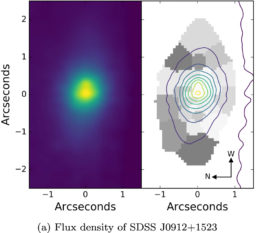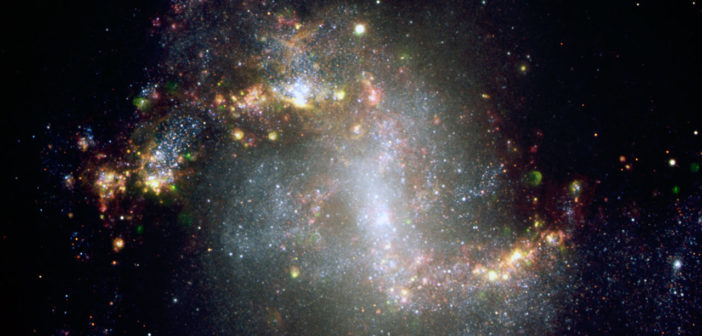At some point in a galaxy’s life, it transitions from a star-forming factory into an old, red, inactive relic. Can new observations of a recently transitioned galaxy help us understand what drives that change?
Causes of Quenching

Spiral starburst galaxies (top) may precede red, inactive ellipticals (bottom) evolutionarily. [Adapted from Hubble/Galaxy Zoo]
But what shuts down the star formation, triggering the transition between these two states? There are a number of possible quenching explanations related to galaxy mergers:
- Gas heating
The collision of two galaxies could heat up the gas supply via shocks, preventing it from gravitationally collapsing to form stars. - Compaction
Mergers may lead to compaction, in which the star-forming gas migrates inward and triggers a central starburst. The remainder of the galaxy is depleted of gas and stops forming stars. - Outflows
Mergers can trigger high-velocity outflows driven by radiation from new stars or from a central, feeding black hole. The outflows remove gas from the galaxy, shutting down star formation. - Morphological quenching
A galaxy can stabilize against star formation if the structure of the galaxy changes — say, after a merger — in specific ways, such as if the galactic disk transforms into a spheroid.
A Transitional Galaxy
These different proposed quenching mechanisms should leave distinctive signatures in the stellar populations of recently quenched galaxies. With this in mind, a team of scientists explored SDSS J0912+1523, an intermediate-redshift galaxy that shows signs of having only recently transitioned from a starburst galaxy to a quiescent one.
In a study led by Qiana Hunt, a postbaccalaureate researcher at Princeton University, the scientists combined preexisting ALMA observations of the gas within SDSS J0912+1523 with new Gemini observations of its stellar population. This combination provided a rare opportunity to gain insight into what might shut down a galaxy’s star formation.
Evidence for a Merger
The authors find that SDSS J0912+1523 shows signs of containing two separate cores of stars that now rotate together — which may be evidence of a past merger.

The flux density of SDSS J0912+1523 seems to show two separate cores, which may be the sign of a past merger. [Hunt et al. 2018]
For now, it looks like the mechanism that shut down star formation in this galaxy remains a mystery. But Hunt and collaborators are optimistic: a number of follow-up observations could shed more light on the problem — like radio hunts for central black-hole activity or high-resolution Hubble images of the galaxy’s morphology. Once these are conducted, we may soon understand what mechanism turns off star formation in an aging galaxy.
Citation
Qiana Hunt et al 2018 ApJL 860 L18. doi:10.3847/2041-8213/aaca9a
